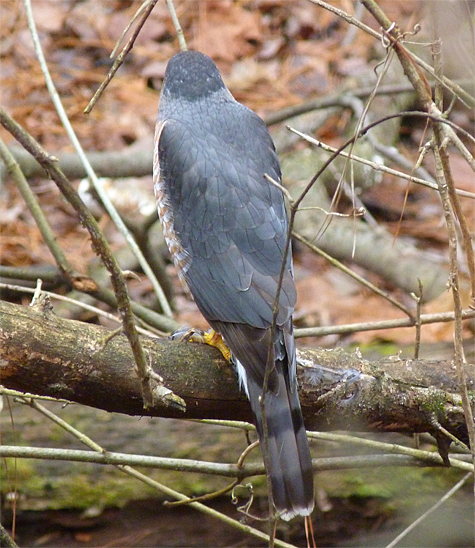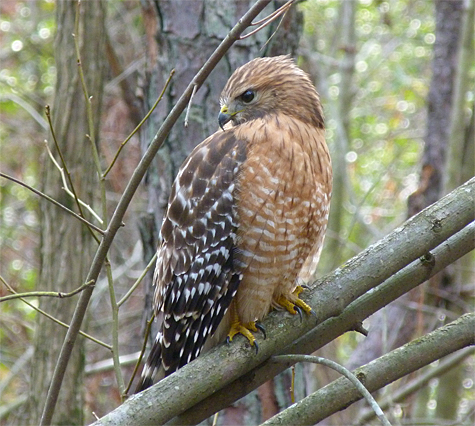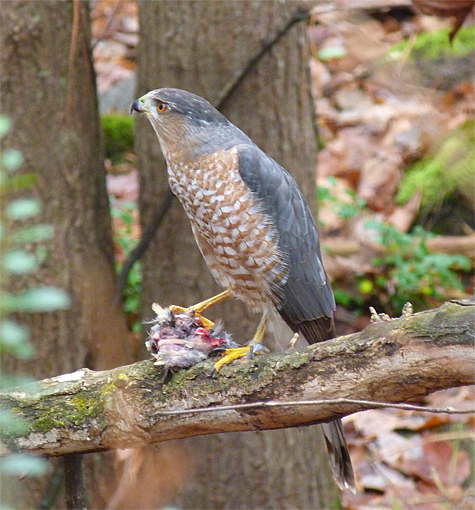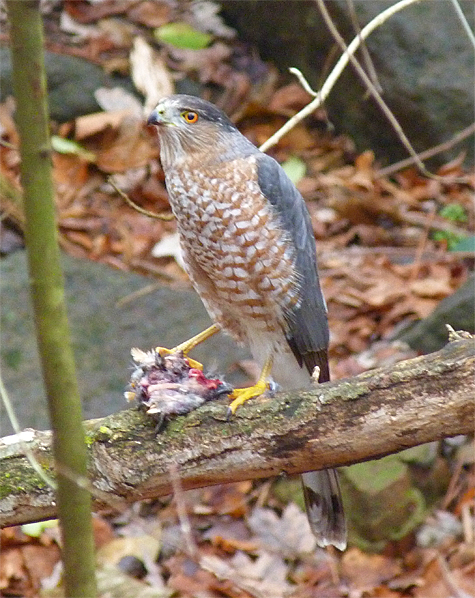As I drove the golf cart along the path through Catch the Wind towards Explore the Wild I saw Ranger Rock standing on the side of the path intently staring at something in the upper swamp, a small wooded swamp on the northeast side of the campus. I parked the vehicle and quietly walked towards Rock.
It was an overcast but warm December day. Ranger Rock had gotten the Bungee Jump set up for business ahead of time and decided to take a look around before opening for the day. As he walked north along the path were it crosses the swamp he noticed a hawk chase and capture a much smaller bird, a songbird.
The hawk had perched on a branch of a downed tree and was plucking and eating its prize when a Red-shouldered Hawk flew in, perching about thirty feet above and to one side of the smaller hawk. The smaller hawk immediately froze, its gaze fixed on the much larger red-shoulder.

The Red-shoulder was apparently not aware of the other raptor as it searched the swamp below for prey. Red-shoulders often come into this swamp looking for frogs, snakes, rodents and whatever else might make a nice meal. Red-shouldered Hawks typically pay little attention to us humans as they hunt throughout the Museum property, as witnessed just a week before as I watched and photographed one hunting a few yards up the path from where we now stood. In fact, this red-shoulder was probably the same bird.

The smaller hawk looked to be a male Cooper’s Hawk. They, unlike the local red-shoulders, do not typically sit still and allow themselves to be scrutinized by curious naturalists as they eat. The red-shoulder’s arrival created an unusual opportunity for me to get photos of both the front and back of this accipiter while it sat fixated on the red-shoulder.

Rock had been on the scene for 5 – 10 minutes before I happened by, and the coop was motionless for more than 15 minutes after I arrived (according to the timestamp on the photos). How long could this waiting game go on? Although clearly out in the open, as long as the smaller hawk remained motionless there was a good chance that the red-shoulder would not see it, or at least not recognize it as prey.
I walked up the path to try and get more shots of the front of the coop. It’s here that the small hawk made its first mistake. As I looked through the viewfinder of the camera I saw the bird blink and move its head ever so slowly in my direction. The hawk couldn’t resist a peek at me as I stood on the path above. Who was the bigger threat, the human or the red-shoulder.

In a flash the red-shoulder dropped down from its perch towards the coop. The coop took off through the understory and trees with the shoulder in hot pursuit. Crashing through the brush and over the hill they went. Had I caused this bird’s demise?
Both of these hawks are built for life flying through woodlands. Proportionately short wings and long tails allow for quick acceleration and rapid twists and turns through the forest. Both traits are exagerated on the coop. Being lighter and smaller, the Cooper’s Hawk racked up even more points in favor of escape.
A few seconds later, beyond the trees, I saw one bird headed towards the left, another towards the right. A close call indeed, but the coop would live to see another day.
Oh, by the way, the Cooper’s Hawk didn’t leave without its prize. The bird flew off with prey in hand, or rather, with prey in talon.
The beginning of a good day!